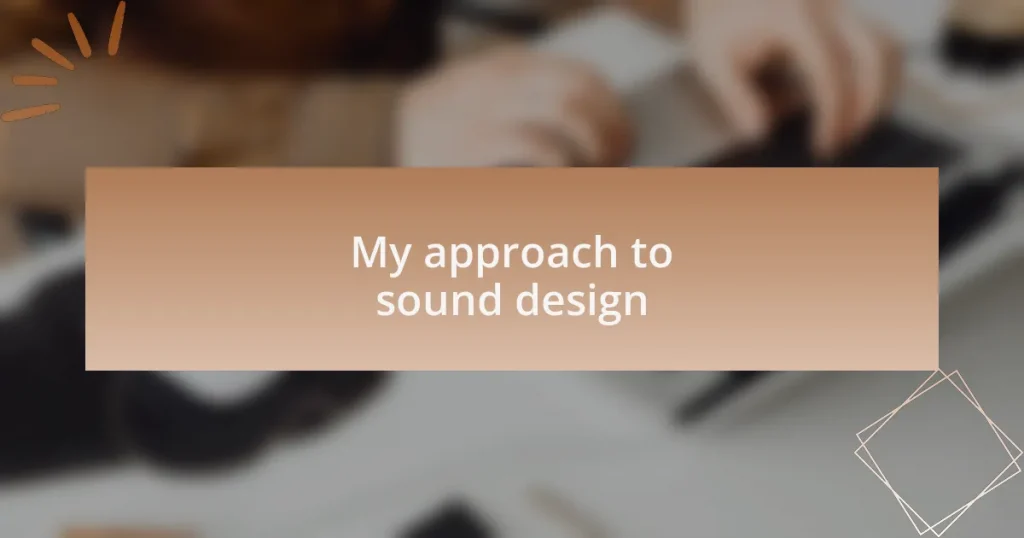Key takeaways:
- Sound design enhances narrative by evoking emotions and creating immersive experiences through techniques like Foley and layering.
- Experimentation with sound sources, including natural and everyday items, can yield unique and evocative audio effects.
- Understanding the psychology of sound is crucial in design, as different frequencies can significantly impact emotions and perceptions.
- Using personal recordings and reflections on emotion can lead to resonant and powerful soundscapes in creative projects.
Author: Clara Whitmore
Bio: Clara Whitmore is an acclaimed author known for her poignant explorations of human connection and resilience. With a degree in Literature from the University of California, Berkeley, Clara’s writing weaves rich narratives that resonate with readers across diverse backgrounds. Her debut novel, “Echoes of the Past,” received critical acclaim and was a finalist for the National Book Award. When she isn’t writing, Clara enjoys hiking in the Sierra Nevada and hosting book clubs in her charming hometown of Ashland, Oregon. Her latest work, “Threads of Tomorrow,” is set to release in 2024.
Understanding sound design principles
Understanding sound design principles goes beyond merely creating pleasing audio; it’s about evoking emotions and enhancing the narrative of a project. For instance, I remember working on a small game where I focused on the sound of footsteps. By experimenting with various surface sounds, I realized how a simple crunch of gravel can heighten tension or bring a sense of adventure. Have you ever noticed how certain sounds can instantly transport you to a different setting?
Moreover, mastering the balance between different sound elements is crucial. I often find myself adjusting levels repeatedly, striving for that perfect mix where dialogue, music, and effects coexist harmoniously. It’s fascinating how a slightly louder background score can elevate a suspenseful moment or how silence, when used skillfully, can amplify the impact of an important dialogue. What’s your experience with sound layering?
Remember, the principles of sound design also encompass the psychology of sound. I’ve seen firsthand how certain frequencies can stir up feelings of anxiety or calmness. I once experimented with a low rumble in a horror project, and it truly made the hairs on my neck stand up! Isn’t it incredible how deeply sound impacts our emotions and perceptions?
My favorite sound design techniques
One of my favorite sound design techniques is the use of Foley, which involves creating and recording sound effects that correspond to specific actions in a project. I remember crafting the sound for a scene where a character opens an old wooden door. I recorded the creak of my own kitchen door, and adding a touch of reverb made it feel like we were really stepping into a grand, mysterious estate. Have you ever tried creating sounds from everyday objects? It truly opens up new creative avenues.
Layering is another technique I love to employ. When I designed sounds for a bustling marketplace scene, I layered different elements like chatter, footsteps, and bell chimes. The result was an immersive soundscape that transported listeners right into the heart of the action. It’s amazing how each layer contributes its unique texture. What layers do you think make a scene come alive?
Finally, I find great joy in using sound modulation to create unique audio effects. In one project, I experimented with pitch shifting to alter the voice of a character who was under a magical spell. The eerie quality that emerged not only fit the narrative but also gave the character an unsettling presence. Have you ever played with pitch modulation? It can dramatically transform auditory storytelling and draw listeners into the experience.
Creating sounds from scratch
Creating sounds from scratch opens up a world of endless possibilities. One of my favorite experiences was when I decided to emulate the sound of a thunderstorm. Using a bowl of water, I struck it with a wooden spoon, which created a surprising splash that captured the essence of rain, while simultaneously shaking a blanket to mimic distant thunder. It’s incredible how simple household items can be transformed into something so evocative. Have you ever thought about using your environment to create sound?
I truly believe experimentation is the heart of sound design. During one project, I took a walk in a nearby forest, capturing the rustling leaves and chirping birds. Later, I manipulated those recordings, adjusting the speed and pitch to create a mystical ambiance that felt like stepping into an enchanted realm. This process reminded me of how nature can inspire us. What sounds from your environment do you think could tell a story?
When creating sounds from scratch, I often reflect on the emotion I want to evoke. I recall designing a sound for a scene depicting solitude; I recorded my own breath and layered it with soft piano notes. The final product was hauntingly beautiful and captured the essence of loneliness perfectly. It amazed me how something so personal could resonate deeply with others. Have you tried experimenting with your own voice or instruments? It can lead to moments of genuine connection in your sound design work.










